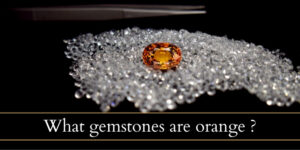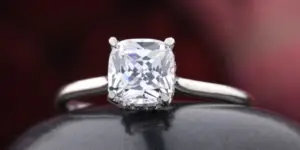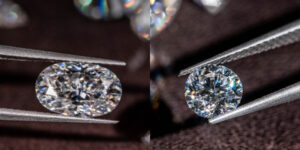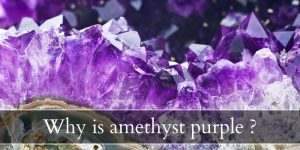Two of the brightest green gemstones, peridot and demantoid garnet are very easy to confuse with one another. This is especially true since demantoid garnets aren’t was widely known as peridots; they’re more of a connoisseur’s gemstone. So how do you tell these two gems apart ? What are the key differences between demantoid garnets and peridots ?
Today we’re comparing them, and telling you the differences we’ve noticed as well as the similarities. This way you know what to watch out for, and, should you want to, know how to substitute one for the other.

Demantoid garnet vs peridot
Demantoid garnets are rarer and more expensive than peridots, and have more brilliance and fire to them than peridots. A key feature of most demantoid garnets is their golden horsehair inclusions, while peridots have no inclusions at all.
What is demantoid garnet ?
Demantoid garnet is a rare form of green garnet, specifically a type of andradite garnet with exceptional luster and scintillation (the combination of fire and brilliance). These garnets are named so after their resemblance to a diamond’s scintillation, which is uncommon in colored gemstones.
Demantoid garnets were discovered in the mid 1800s in Russia, and because of the region and the color of the gem, they’ve also been named Russian emerald or Siberian emerald. Another large source of demantoid garnet was found in West Africa in the late 1900s, but Russia continues to be the major producer.
What is peridot ?
Peridot is the gem-quality version of olivine, as this gem rarely forms in crystals large enough to be used in jewelry. Peridots are very interesting as they’re either extraterrestrial (such as those from a specific type of meteorite) or formed as a result of volcanic activity. Peridots occur in an olive-green color, with the yellow hue dictated by the amount of iron in it. The more iron, the more yellow the gem has, and it can sometime be almost brown.
Read also: Blue Diamond VS Aquamarine
Now let’s take a key look at the differences between peridot and demantoid garnet, to better tell them apart.
1. Demantoid garnets have strong fire and brilliance, unlike peridots
Demantoid garnets were named so because of their amazing brilliance and fire. Normally colored gems have their body color so saturated and such a different luster that they simply can’t reflect as much light as a diamond. Don’t think demantoid garnets are just like green diamonds though ! No, they’re not as brilliant but they’re far more brilliant than any other colored gem.
This is especially true when compared to peridot. Demantoid garnets have adamantine luster, which is perfectly smooth and almost mirror-like, which allows light to enter exactly as it is. Peridot has a glassy to oily luster, which diffuses the light a little when it enters the gem, so it cannot reflect back as bright or as colorful. There is also higher clarity within the gem body in a demantoid garnet than a peridot.
2. Peridots are far more affordable than demantoid garnets
Demantoid garnets are simply more expensive due to their rarity and brilliance. You can find them for about $3,500 per carat for a minimal but noticeable inclusion pattern and a yellow-green color. Vivid green demantoid garnets can sell for more.
Meanwhile peridots sell for an average of $150 per carat for a vivid color gem with plenty of green and high clarity.
3. Demantoid garnets are rare, peridots are easier to come by
Peridots also have the upper hand in how easy it is to get one. Or, perhaps you could say this means demantoid garnets have the upper hand, since they’re rarer and not as well known and they’re more difficult to source. It depends on how you look at it.
The point is that if you’re looking to get your gemstone quickly, whether it’s a loose stone or already set in jewelry, peridot will be much faster and much easier to find in the shape and size you’re looking for. If your heart is set on demantoid garnet you can still find it, but will need a bit of patience.
4. Peridots don’t usually have inclusions, demantoid garnets do
Inclusions are highly desirable in a demantoid garnet. These gems are well known for their thin, wispy inclusions called horsehairs. They appear golden and like a horse’s tail fluttering in the wind. Not all demantoid garnets have these inclusions but most of them do, enough for most people to look for this ‘signature’.
Meanwhile peridots don’t have this inclusion, or rather they don’t show any inclusions at all. These gems are eye-clean nearly every time, and that is one key way of figuring out which is which.
A related point is that peridots are almost always golden-green, and appear so without any inclusions. Demantoid garnets that appear golden-green do so because of those fine golden inclusions.
Similarities between peridots and demantoid garnets
There are two important similarities between demantoid garnets and peridots, and they’re important enough to make you think twice about which gem to go with. These similarities are especially important if you’re looking to use peridot in place of demantoid garnet, if the situation calls for it.
1. Peridot and demantoid garnet have the same hardness rating
A gem’s hardness is a way to measuring how resistant it is to scratches and chipping. Both peridots and demantoid garnets have the same rating, 6.5 on the Mohs scale, which goes all the way to 10. This is an unbalanced scale, as 10 is 4 times stronger than 9, which is 2 times stronger than 8, and so on. So a score of 6.5 is not the worst BUT it does call for extra care when choosing a setting.
The setting should be very protective, such as a bezel or many prongs (like 6 or 8) and the gemstone should not sit very high if it’s a ring stone.
This also means that a demantoid garnet and a peridot will scratch and get cloud at about the same rate, so neither has the upper hand here.
2. Demantoid garnet and peridot have very similar colors
Color was probably a key factor for your decision to look for demantoid garnets and peridots. Well, these two gems are so alike they are often confused with one another.
Peridots come in a golden-green color, usually quite bright and vivid. Some specimens have bit more iron in them and have a more pronounced golden hue, but those aren’t very common. Demantoid garnets tend to have a vivid green body and a slight golden hue, mostly due to the inclusions. It’s usually the Russian demantoid garnets that have the most vivid green body color.

I’m the main author for jewelrymaterialguide.com. I started this site after we did tons of research before our wedding and noticed that there is information about rings, jewelry, and so on that is really hard to find on the internet.






